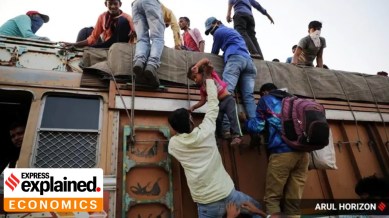Economic Survey 2023-24 to be released today: Why it matters, what to expect
Presented a day before the Union Budget, the Economic Survey is a comprehensive report of the state of the Indian economy.

Union Finance Minister Nirmala Sitharaman will release the Economic Survey 2023-24 on Monday (July 22), the first day of the monsoon session of Parliament.
The survey typically comes out on January 31, a day before the Finance Minister presents the Union Budget for the next financial year.
However, in election years like 2024, the government takes a different route and presents a shorter report titled “The Indian Economy – A Review” and tables an interim budget in February. After the dissolution of the parliament and the conclusion of elections, the newly-elected government presents a comprehensive Economic Survey and Budget for the financial year.
What is the Economic Survey?
As the name suggests, the Economic Survey is a detailed report of the state of the national economy in the financial year that is coming to a close. It is prepared by the Economic Division of the Department of Economic Affairs (DEA) in the Union Finance Ministry, under the guidance of the Chief Economic Adviser. Once prepared, the Survey is approved by the Finance Minister.
The first Economic Survey was presented for 1950-51 and until 1964, it was presented along with the Budget.
Similarly, for the longest time, the survey was presented in just one volume, with specific chapters dedicated to different key sectors of the economy such as services, agriculture, and manufacturing, as well as key policy areas like fiscal developments, state of employment and inflation etc. This volume carries a detailed statistical abstract as well.
However, between 2010-11 and 2020-21, the survey was presented in two volumes. The additional volume carried the intellectual imprint of the CEA and often dealt with some of the major issues and debates facing the economy.
From 2022-23, the survey reverted to a single volume format, presumably because it was prepared and presented while there was a change in guard in the CEA’s office and the current CEA – V Anantha Nageswaran – took charge when the survey was released.
What is the Economic Survey’s significance?
Even though it comes just a day before the Budget, the assessment and recommendations carried out in the survey are not binding on the Budget.
Nevertheless, the survey remains the most authoritative and comprehensive analysis of the economy that is conducted from within the Union government. Its observations and details provide an official framework for analysing the Indian economy.
What should one look for in this year’s survey?
The Indian economy has struggled to grow at a fast pace since 2017-18. The years immediately after the Covid-19 pandemic may have registered fast growth rates but that was just a statistical illusion. Many outside economists have argued that India’s potential growth has fallen from 8% to 6%.
The International Monetary Fund (IMF) in July this year revised India’s growth forecast for 2024-25 from 6.8% to 7%, an increase due to an improvement in private consumption especially in rural India, in spite of challenging global and domestic economic dynamics. The IMF’s World Economic Outlook report has also projected 6.5% GDP growth for India in 2025-26.
But some major challenges persist. The economy witnessed historically high unemployment and a sharp rise in poverty and inequality during the Covid years. This loss of employment has been significant in the unorganised sector, with the closure of many informal units over the last seven years, and the loss of about 16.45 lakh jobs, according to recent data from the Annual Survey of Unincorporated Enterprises (ASUSE).
The survey is expected to diagnose the true extent of economic recovery in the Indian economy and assess India’s growth potential. It can be expected to paint future scenarios and suggest policy solutions. For instance, what can be done to boost manufacturing growth in the country? How can India continue to grow fast at a time when both global growth and world trade remain muted?
Lastly, this survey, like its predecessor, will bear the imprint of CEA Nageswaran. As such, it could carry chapters that analyse the key issues and challenges facing the economy and the likely solutions.
This is an edited version of an explainer first published in 2023.